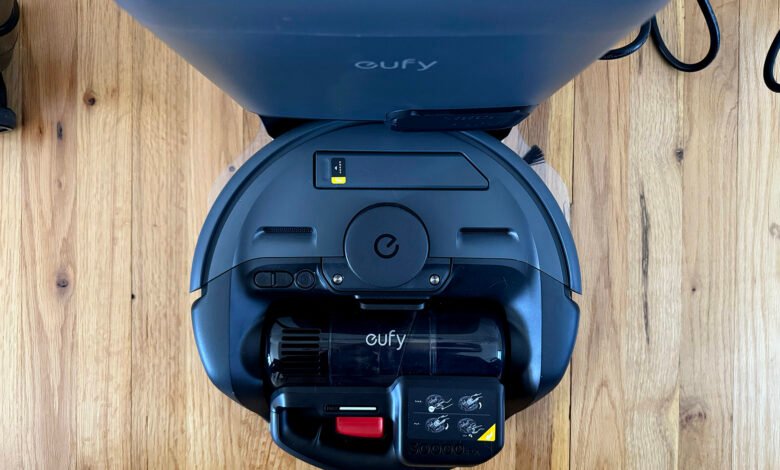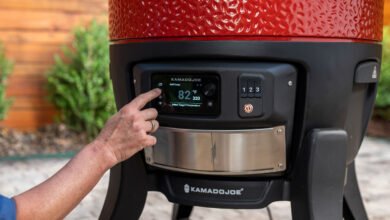Anker Eufy E20 review: A robot vacuum that transforms to do more

Convenience has always been the big promise of robot vacuums. Don’t clean your house yourself — instead, push a button and have a little robot putter around your home, sucking up all the dirt and debris in its path. Indeed, they are convenient, but they haven’t fully replaced a manually operated cordless vacuum.
Chances are, you have either a robot vacuum or a cordless vacuum in your house right now. Anker’s home brand Eufy wants us to live in a world where you can have both without spending money on two separate devices that need two separate spots in your home. Announced at CES 2025, Anker’s Eufy E20 is a first-of-its-kind robot vacuum that turns into a cordless stick vacuum and comes with all the necessary attachments to do so, plus a self-emptying base. It even comes in at a midrange price of $600 (or $50 less if you pre-order before it comes out on February 10), which made me believe that it has to be too good to be true. Ultimately, it succeeds at all three of its intended jobs, but really shines with only one of them.
Design and setup
Despite being a 3-in-1 device, the E20 sets up primarily as a robot vacuum. It comes in two main parts: the robot and the self-emptying base. There’s really no assembly required — the base is fully put together in the box and only requires you to attach a transparent mat (onto which the vacuum docks) and plug the whole thing into the wall. Sit the robot vacuum on the base and it’ll charge up, and it pairs quickly over Wi-Fi with the Eufy Clean mobile app.
Two of the “three in one” modes come as accessories included in the box. For the cordless stick vacuum, you get a retractable stick and a floor cleaner head, and for the handheld vacuum, you get a smaller, more precise brush attachment that’s ideal for couches, chairs, cars and more. The only thing you don’t get is a place to store those accessories; Eufy will sell a wall-mounted bracket that you can buy for an additional $30. It’s great that it’s such an affordable add-on but annoying that it is, in fact, a separate purchase. If you have the space, you may be better off storing the stick-vac accessories in your laundry room or a nearby closet.
Yes, this is a “smart” device, but all of the smart features of the E20 are limited to its robot-vaccum form. That’s not entirely surprising; robovacs literally depend on features like customizable cleaning schedules, auto-docking, self-emptying and home mapping to be valuable. That’s not the case for cordless vacuums, which remain manually operated devices. Some of the cordless vacuums I’ve tested have companion apps, but those typically just tell you when a filter needs to be cleaned and how long until the device is fully charged. Nice, but not necessary.
The Eufy E20 as a robot vacuum
Since the E20’s default form is robot vacuum, I tried it out as such first. This model supports smart home mapping, so the initial run included creating a map of the main floor of my home. It took around 10 minutes for the robot to scoot around the house and create an accurate map, and then it immediately got to work cleaning. Editing the map in the Eufy Clean app was a breeze, allowing me to match auto-generated “rooms” to the rooms in my home, label them properly and set no-go zones around my cat’s food and water bowls.
Every robot vacuum app will tell you to pick up anything on your floors that shouldn’t be there before starting a cleaning job, and Eufy’s does this as well. I purposefully do not follow these instructions so I could test out a device’s obstacle avoidance features. The E20 impressed me on this front: it avoided a bunch of small boxes on the floor of my family room, shoes in the hallway and my cat’s bowls before I even set a no-go zone around them. It only got stuck and called for help (via an error message) once when it got caught on a wonky corner of the mat that sits in front of the door leading out to my deck. Extricating the robovac was easy (with no damage to either it or the mat) and the machine continued to clean after that as if nothing had happened.
The E20 has four cleaning modes you can choose from in the app before you start a job: Quiet, Standard, Turbo and Max. There’s also a BoostIQ setting you can turn on which will kick up the suction power when the robot vacuum is cleaning long-pile carpets. I kept this setting on at all times, even though the main level of my house has only tile and hardwood floors. Overall, as a robot vacuum, the E20 is great at cleaning and avoiding most objects in its path. It’s also one of the most responsive robovacs I’ve tried in that, within a second of, say, telling it to go home from within the Eufy Clean app, it starts heading to the base station.
During a job, it’s also smart enough to know when its dustbin is getting full and it will return to its dock to auto-empty before continuing to clean. It did so about four times when it cleaned the main floor of my house, and that was consistent every time I used it. Usually at the end of a job, the E20 had about 40 percent battery left before it went home on its own. The self-emptying bin is a bit smaller than others I’ve used with competing robovacs, but Eufy claims it can hold up to 75 days worth of debris.
The Eufy Clean app has come a long way since I first started testing Anker robot vacuums. It’s still not as simple as apps like iRobot’s or Shark’s, but I mostly chalk that up to the fact that Eufy stuffed a lot of features into the app. You can quickly tell the robovac to start cleaning, return to its dock or change the cleaning mode with a press of a button on the main page, or tap into the device’s profile to access the home map and even more settings.
Two charming things this app has that most others don’t are manual directional controls, so you can treat the robot almost like an RC car, and a little robot avatar that appears on the home map while it’s moving, so you can see exactly where it is in your home and where it’s already cleaned. Admittedly, the latter is likely more practical for most people than the former, but both are features that aren’t as common in robot vacuums — even the high-end ones.
The Eufy E20 as a cordless stick vacuum
It’s easy to transform the E20 from a robot vacuum into a cordless stick vacuum. Just press the large red button on the robot vacuum to eject its cleaning module (which includes the filtration system, fan motor and dust cup), lift it up and out of the robot shell and attach the stick vacuum arm to its underside. The arm extends and retracts so you can use it to clean your floors with the included roller brush head or to tackle hard-to-reach spots with the precision head. There’s an elegance to this that impresses me: it’s so simple to do and requires very little tweaking by the user — anyone who’s used a regular cordless stick vacuum with multiple attachments will be very familiar with this process.
But how good is it as a cordless vacuum? The answer is: just ok. If the E20 were only a stick vacuum, it probably wouldn’t be a top pick in our guide. This device is clearly a robot vacuum first, stick-and-hand vac second, and it’s just not as powerful or efficient as other cordless vacuums I’ve tested. It does have four cleaning modes, each with different levels of suction power, and I always found myself using the strongest to get the deepest clean — both on carpets and hard floors. It didn’t choke at the first sign of pet hair, though, and it actually captured a lot of my cat’s fur hiding in my carpet. But it took at least two passes on carpets in particular to grab the biggest pieces of debris in its path.
The E20 as a cordless stick vac does get points for being a single-button start device and having attachments that are easy to swap. While most of these machines are made mostly of plastic, the E20 feels noticeably cheap when compared to a stick vac from Tineco or Dyson. That may have to do with the fact that the overall design is quite small — the guts have to fit into a compact robot vacuum, after all — and it has a small dustbin.
Some might appreciate that, though, since it means you can more easily take it out to your car or somewhere else while it runs on battery power. It’s also worth noting that, despite the small dustbin, I never received an alert that the dustbin was too full and needed to be emptied before I could continue vacuuming. I also never had to stop in the middle of a manual cleaning to recharge; most often, the vacuum had around 30 percent battery left after I cleaned all three floors of my home (which usually takes me between 20 to 30 minutes). According to Eufy, the vacuum takes only 2.5 hours to charge up from 0 to 100 percent, too.
The machine also has a nifty feature that will auto-empty the dustbin after a cordless-vac cleaning job, which means you don’t have to empty it yourself even when you opted to actually clean yourself. Just pop the module back into the robot vacuum and press the Home button for a few seconds and it will auto-empty just as it would if the robot did all the hard work.
Wrap-up
All told, the Eufy E20 is an impressive machine. While Eufy isn’t a stranger to making solid robot vacuums, this device is still a first-gen product in my mind — and a solid one at that. But you have to know what you’re buying upfront: an above-average robot vacuum that can turn into a just-average stick and hand vacuum.
Ultimately, the convenience that comes from its 3-in-1 design may be enough to overlook the just-average performance of two of the three uses. The E20 isn’t the best stick vac on the market, but honestly, I never expected it to be. It’s good enough that it handily supplements the robot vacuum portion of the machine, allowing you to buy just one device that can vacuum autonomously for you most of the time and let you clean tricky spots manually when you need to.
The price is also quite decent when you consider the machine’s convenience mixed with its good performance. Some robot vacuums come in at $600 and provide only a self-emptying base as their main perk. Other similarly priced devices include mopping capabilities and that may be more useful for folks who have a variety of floor types in their home. Also consider this: you’d spend roughly the same amount if you got both our top budget cordless stick vacuum (the $300 Tineco Pure One S11) and our favorite budget robot vacuum (the $250 Roomba Vac), but you’d be missing a self-emptying base and you’d have to house two separate devices in your home.
This article originally appeared on Engadget at https://www.engadget.com/home/smart-home/anker-eufy-e20-review-a-robot-vacuum-that-transforms-to-do-more-150005198.html?src=rss
Source link




